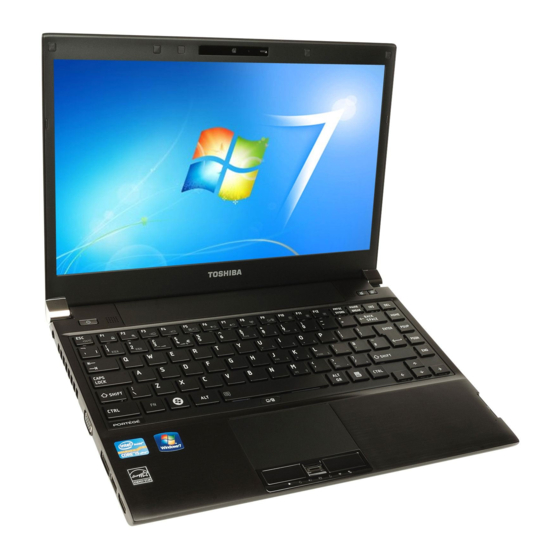
Toshiba Portege R830 Laptop Manuals
Manuals and User Guides for Toshiba Portege R830 Laptop. We have 2 Toshiba Portege R830 Laptop manuals available for free PDF download: Maintenance Manual, User Manual
Toshiba Portege R830 Maintenance Manual (515 pages)
Personal Computer
Table of Contents
-
-
Features15
-
Hdd&Ssd29
-
Sata Ssd31
-
Keyboard34
-
Power Supply36
-
Batteries38
-
RTC Battery40
-
AC Adapter41
-
-
-
E5V Output58
-
Main Battery58
-
Nd Battery58
-
S3V Output58
-
E3V Output59
-
Ppv Output59
-
Ptv Output60
-
Troubleshooting104
-
-
-
Diagnostics Menu116
-
Heatrun Test128
-
Subtest Names129
-
System Test131
-
Keyboard Test134
-
Display Test135
-
Floppy Disk Test138
-
Printer Test140
-
Async Test142
-
Hard Disk Test143
-
Real Timer Test146
-
NDP Test148
-
Expansion Test149
-
Only One Test157
-
Operations157
-
Head Cleaning169
-
Operations169
-
Log Utilities170
-
Operations171
-
Operations172
-
Running Test172
-
Operations174
-
Operations179
-
LAN Test191
-
Bluetooth Test195
-
-
Main Menu199
-
Security Menu199
-
Advanced Menu200
-
Exit Menu201
-
-
Setup199
-
Outline207
-
Starting from CD208
-
Windows PE T&D210
-
Dos T&D256
-
-
-
Overview295
-
Battery Pack304
-
Figure304
-
Figure306
-
SIM Card306
-
Expresscard307
-
Figure307
-
Figure308
-
Memory Module309
-
Hdd/Ssd312
-
Base Assembly317
-
Expresscard Slot323
-
Battery Lock325
-
Card326
-
DC Fan340
-
E-SATA Board342
-
Fin344
-
Removing the Fin344
-
Bluetooth Module346
-
System Board348
-
Sound Board357
-
Speaker363
-
DC-IN Harness366
-
Keyboard372
-
Lcd380
-
Camera Module388
-
(No-3G Model)391
-
Figure395
-
Hinge413
-
Appendices415
-
-
Appendix
417
Advertisement
Toshiba Portege R830 User Manual (245 pages)
R830-S8310 User's Guide
Table of Contents
-
Introduction40
-
This Guide42
-
Safety Icons43
-
-
-
Computing Tips100
-
Saving Your Work107
-
-
-
-
Battery Notice118
-
Power Management119
-
-
Traveling Tips135
-
-
-
TOSHIBA Assist148
-
Connect149
-
Secure150
-
Protect & Fix151
-
Optimize152
-
-
Mouse Utility163
-
-
-
The Windows181
-
Memory Problems185
-
Display Problems187
-
-
Error-Checking189
-
-
Printer Problems194
-
-
Hot Key Cards207
-
-
Volume Mute210
-
Power Plan212
-
Sleep Mode213
-
Hibernation Mode214
-
Numeric Overlay219
-
Advertisement

